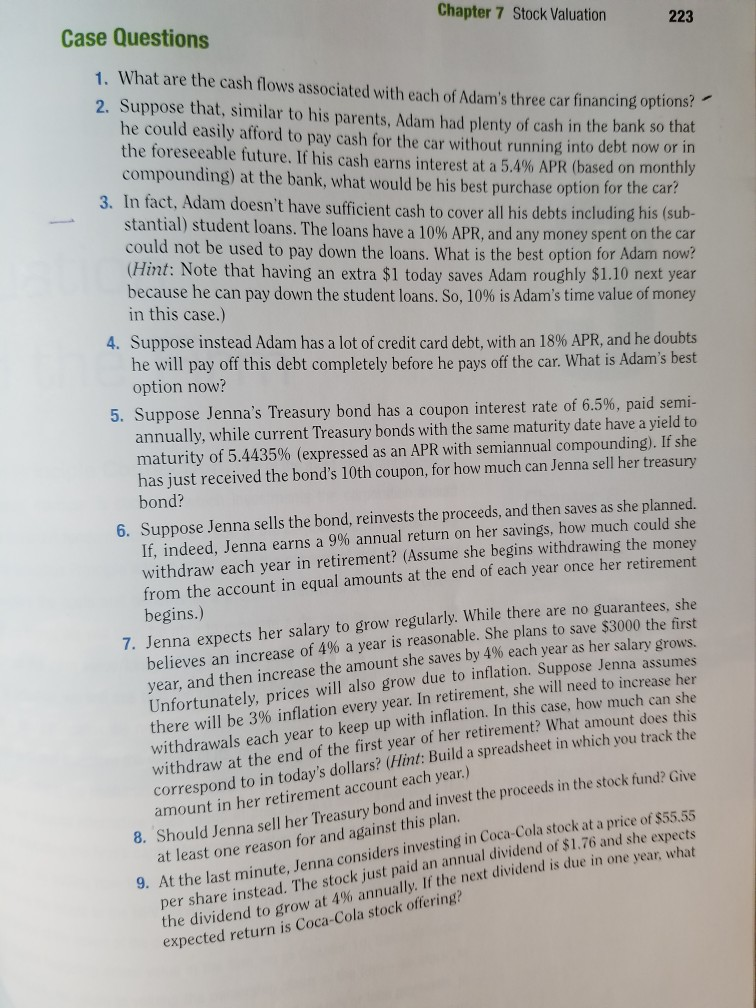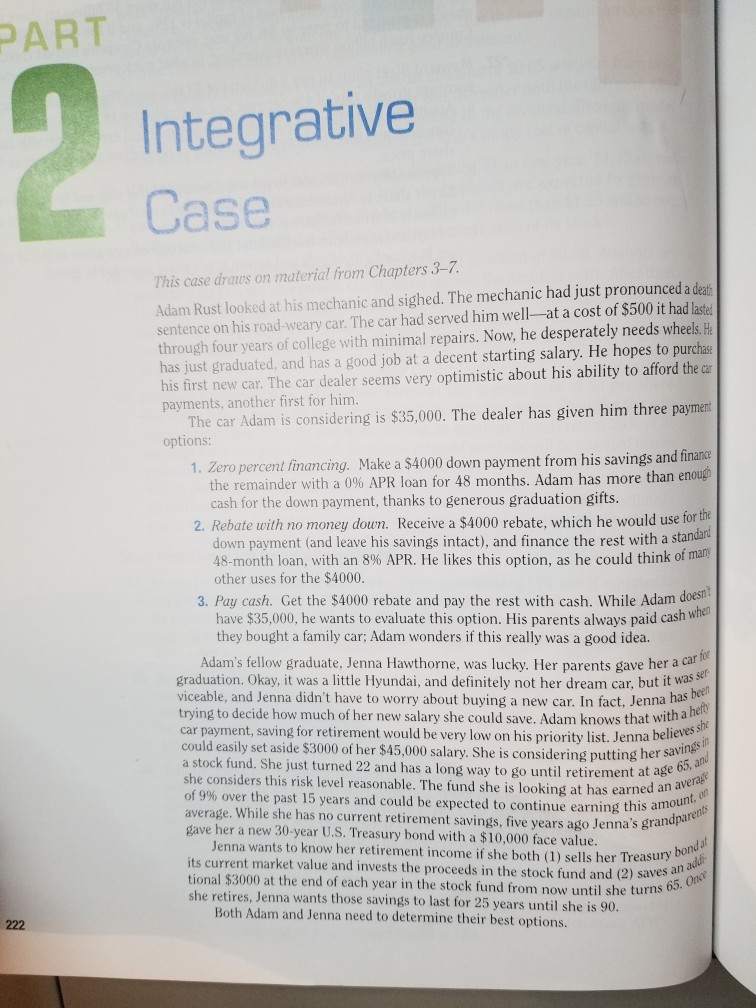Urgent... Integrative Case of Corporate Finance (Adam Rust looked at his mechanic and sighed..........)
Kindly equip me with answers please, thank you extremely much

Chapter 7 Stock Valuation Case Questions 223 1. What are the cash flows associated with each of Adam's three car financing options? 2. Suppose that, similar to his parents, Adam had plenty of cash in the bank so th he could easily afford to pay cash for the car without running into debt now or in the foreseeable future. If his cash earns interest at a 5.4% APR (based on monthly compounding) at the bank, what would be his best purchase option for the 3. In fact, Adam doesn't have sufficient cash to cover all his debts including his (sub- stantial) student loans. The loans have a 10% APR, and any money spen could not be used to pay down the loans. What is the best option for Adam now? Hint: Note that having an extra $1 today saves Adam roughly $1.10 next year because he can pay down the student loans. So, 10% is Adam's time value of money in this case.) 4. Suppose instead Adam has a lot of credit card debt, with an 18% APR, and he doubts he will pay off this debt completely before he pays off the car. What is Adam's best option now? 5. Suppose Jenna's Treasury bond has a coupon interest rate of 6.5% annually, while current Treasury bonds with the same maturity date have a yield to maturity of 5.4435% (expressed as an APR with semiannual compounding). If she has just received the bond's 10th coupon, for how much can Jenna sell her treasury bond? 6. Suppose Jenna sells the bond, reinvests the proceeds, and then saves as she planned. If, indeed, Jenna earns a 9% annual return on her savings, how much could she withdraw each year in retirement? (Assume she begins withdrawing the mo from the ac count in equal amounts at the end of each year once her retirement gin 7. Jenna expects her salary to grow regularly. While there are no guarantees, she believes an increase of 4% a year is reasonable. She plans to save $3000 the first year, and then increase the amount she saves by 4% each year as her salary grows. there will be 3% inflation every year. In retirement, she will need to increase her today's dollars? (Hint: Build a spreadsheet in which you track the sury bond and invest the proceeds in the stock fund? Give Unfortunately, prices will also grow due to inflation. Suppose Jenna assumes withdrawals each year to keep up with inflation. In this case, how much can she What amount does this withdraw at the end of the first year of her retirement? correspond to in dollars t in her retirement account each year.,) hould Jenna sell her Trea at least one reason for and aga 8. S inst this plan of $55.55 sting in Coca-Cola stock at a price he last minute, Jenna considers inve r share instead. The stock just paid an annual dividend of e dividend to grow at 4% annually. If the next dividend is due in on 6 and she expects what 9. At t year, w expected return is Coca-Cola stock offering? PART Integrative Case This case draus on material from Chapters 3-7. Adam Rust looked at his mechanic and sighed. The mechanic had just pronounced a death sentence on his road-weary car. The car had served him well-at a cost of $500 it had laste through four years of college with minimal repairs. Now, he desperately needs wheels. He has just graduated, and has a good job at a decent starting salary. He hopes to purchae his first new car. The car dealer seems very optimistic about his ability to afford the a payments, another first for him The car Adam is considering is $35,000. The dealer has given him three payment options: 1. Zero percent financing. Make a $4000 down payment from his savings and finan noug the remainder with a 0% APR loan for 48 months. Adam has more than e cash for the down payment, thanks to generous graduation gifts. 2. Rebate with no money doun. Receive a $4000 rebate, which he would use for down payment (and leave his savings intact), and finance the rest with a standar 48-month loan, with an 8% APR. He likes this option, as he could think of many other uses for the $4000 3. Pay cash. Get the $4000 rebate and pay the rest with cash. While Adam doesn have $35,000, he wants to evaluate this option. His parents always paid cash win they bought a family car; Adam wonders if this really was a good idea. for Adam's fellow graduate, Jenna Hawthorne, was lucky. Her parents gave her a car graduation. Okay, it was a little Hyundai, and definitely not her dream car, but it was viceable, and Jenna didn't have to worry about buying a new car. In fact, Jenna has trying to decide how much of her new salary she could save. Adam knows that witha h car payment, saving for retirement would be very low on his priority list. Jenna believes could easily set aside $3000 of her $45,000 salary. She is considering putting her a stock fund. She just turned 22 and has a long way to go until retirement at er savings 65, a nsiders this risk level reasonable. The fund sh e is looking at has earned an aver t. of 9% over the past 15 years and could be expected to continue earning this amour et average. While she has no current retirement savings, five years ago Jenna's gra gave her a new 30-year U.S. Treasury bond with a $10,000 face value dparents Jenna wants to know her retirement income if she both (1) sells her Treasury its current market value and invests the proceeds in the stock fund and (2) saves an tional $3000 at the end of each year in the stock fund from now until she turns she retires, Jenna wants those savings to last for 25 years until she is 90. 65. Both Adam and Jenna need to determine their best options








